

Identification and characterization of a new soybean promoter induced by Phakopsora pachyrhizi, the causal agent of Asian soybean rust. Ecological differentiation and incipient speciation in the fungal pathogen causing rice blast. Flax rust infection transcriptomics reveals a transcriptional profile that may be indicative for rust Avr genes. Abstract Secreted effectors of fungal pathogens are essential elements for disease development.
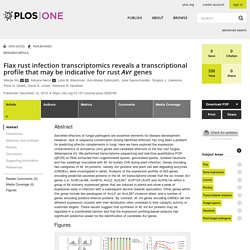
However, lack of sequence conservation among identified effectors has long been a problem for predicting effector complements in fungi. Here we have explored the expression characteristics of avirulence (Avr) genes and candidate effectors of the flax rust fungus, Melampsora lini. We performed transcriptome sequencing and real-time quantitative PCR (qPCR) on RNA extracted from ungerminated spores, germinated spores, isolated haustoria and flax seedlings inoculated with M. lini isolate CH5 during plant infection. Genes encoding two categories of M. lini proteins, namely Avr proteins and plant cell wall degrading enzymes (CWDEs), were investigated in detail. Citation: Wu W, Nemri A, Blackman LM, Catanzariti A-M, Sperschneider J, Lawrence GJ, et al. (2019) Flax rust infection transcriptomics reveals a transcriptional profile that may be indicative for rust Avr genes.
Copyright: © 2019 Wu et al. Transcriptome-wide association study identifies putative elicitors/suppressor of Puccinia graminis f. sp. tritici that modulate barley rpg4 -mediated stem rust resistance. The original goal of this research was to identify Puccinia graminis f. sp. tritici genes representing dominant avirulence factors that interact and elicit defense responses through the Rpg5 gene, the major R-gene underlying RMRL [31, 32].
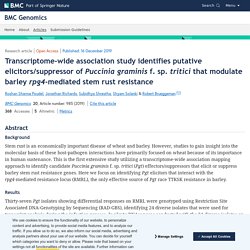
These original assumptions followed the central dogma of Flor’s gene-for-gene hypothesis [47], which has held up in characterized Flax-flax rust [37] and wheat-wheat stem rust [36, 38] pathosystem interactions. However, gene expression comparisons of both the host and pathogen during the infection process with a set of RMRL and Rpg1 virulent -vs- avirulent isolates (Table 2; Additional file 1: Table S13) led to the development of the different hypothesis; dominant virulence genes suppress defense mechanisms in barley that are elicited by the barley stem rust resistance gene Rpg5 at the RMRL. A single time point (5DPI), that had shown effector expression during the colonization process [17] was used for analysis.
Host-parasite interaction during subepidermal sporulation and pustule opening in rust fungi ( Pucciniales ) Molecular Characterization of International Collections of the Wheat Stripe Rust Pathogen Puccinia striiformis f. sp. tritici Reveals High Diversity and Intercontinental Migration. Endemic and panglobal genetic groups, and divergence of host-associated forms in worldwide collections of the wheat leaf rust fungus Puccinia triticina as determined by genotyping by sequencing. Genome compartmentalization predates species divergence in the plant pathogen genus Zymoseptoria. Cryptosexuality and the Genetic Diversity Paradox in Coffee Rust, Hemileia vastatrix. Abstract Background Despite the fact that coffee rust was first investigated scientifically more than a century ago, and that the disease is one of the major constraints to coffee production - constantly changing the socio-economic and historical landscape of the crop - critical aspects of the life cycle of the pathogen, Hemileia vastatrix, remain unclear.
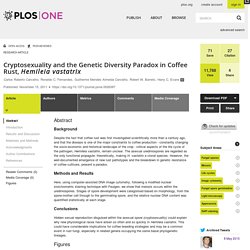
The asexual urediniospores are regarded as the only functional propagule: theoretically, making H. vastatrix a clonal species. However, the well-documented emergence of new rust pathotypes and the breakdown in genetic resistance of coffee cultivars, present a paradox. Methods and Results Here, using computer-assisted DNA image cytometry, following a modified nuclear stoichiometric staining technique with Feulgen, we show that meiosis occurs within the urediniospores. Conclusions Editor: Kirsten Nielsen, University of Minnesota, United States of America Received: June 6, 2011; Accepted: September 26, 2011; Published: November 15, 2011. Emergence of the Ug99 lineage of the wheat stem rust pathogen through somatic hybridisation. Prospects for Durable Resistance Against an Old Soybean Enemy: A Four-Decade Journey from Rpp1 (Resistance to Phakopsora pachyrhizi) to Rpp7. Soybean rust (SBR), caused by Phakopsora spp., is a major global concern for soybean producers.
SBR causing fungi are polycyclic and obligate biotrophs, rendering the study of their biology particularly tedious. Over the past four decades, substantial progress has been made towards understanding the epidemiology of the disease, the identification of sources of resistance, and the mapping of soybean loci conferring resistance to P. pachyrhizi (Rpp genes), since this species is particularly well established and widespread in many soybean growing areas. Although host-plant resistance is generally considered as the most desirable solution from an environmental, economic, and social perspective, other disease control approaches such as agronomic practices and chemical application are also important, and influence rust epidemiology as well as the durability of host plant resistance. Leaf rust ( Puccinia triticina) mediated RNAi in wheat ( Triticum aestivum L.) prompting host susceptibility.
First report of winter survival of Phakopsora pachyrhizi on kudzu ( Pueraria lobata), in the province of Buenos Aires, Argentina. Open Access Disease Note First Online: 12 March 2019 Soybean rust Fungus survival Molecular characterization of Phakopsora pachyrhizi Asian soybean rust (ASR), caused by Phakopsora pachyrhizi, was first reported in 2002 in Argentina (Rossi 2003).
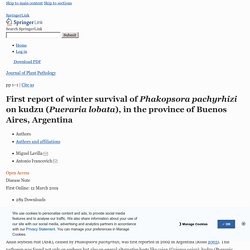
A comparison of isozymes of Phakopsora pachyrhizi from the eastern hemisphere and the new world. Duplications and losses in gene families of rust pathogens highlight putative effectors. Introduction Rust fungi are plant infecting filamentous fungi in the order Pucciniales (Basidiomycota) that are unified by obligate biotrophy (Voegele and Mendgen, 2011).

This form of pathogenicity requires a live host to establish a parasitic relationship. This is accomplished through the establishment of a molecularly intimate interaction at the host-pathogen interface characterized by the secretion of an arsenal of proteins from the pathogen that suppress host defense mechanisms and promote the acquisition of essential nutrients by the pathogen (Dodds et al., 2009; Stergiopoulos and de Wit, 2009). Such proteins, termed effectors, are thought to establish and maintain a compatible interaction between the pathogen and host.
Secreted proteins can be identified from whole genome sequences through the utilization of bioinformatic tools to isolate proteins with N-terminal secretion signals. From single nuclei to whole genome assemblies. Diagnostic Fact Sheet for Phakopsora meibomiae. American soybean rust -Phakopsora meibomiae Phakopsora meibomiae is a rust native to the tropical and subtropical regions of the Americas that has a broad host range among legume species.
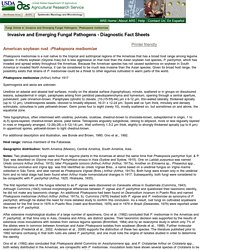
It infects soybean (Glycine max) but is less aggressive on that host than the Asian soybean rust species, P. pachyrhizi, which has invaded and spread widely throughout the Americas. Because the American species has not caused epidemics on soybean in South America or invaded North America, it can be considered to be much less invasive than the Asian species. Given its broad host range, the possibility exists that strains of P. meibomiae could be a threat to other legumes cultivated in warm parts of the world. Phakopsora meibomiae (Arthur) Arthur 1917 Spermogonia and aecia are unknown. Telia hypophyllous, often intermixed with uredinia, pulvinate, crustose, chestnut-brown to chocolate-brown, subepidermal in origin, 1 to 4(-5) spore-layered, chestnut-brown above, paler below. First Report of Phakopsora pachyrhizi Telia on Kudzu in the United States. Draft genome sequence resource of switchgrass rust pathogen, Puccinia novopanici isolate Ard-01.
Genome sequencing and transcript analysis of Hemileia vastatrix reveal expression dynamics of candidate effectors dependent on host compatibility. A bifunctional dermaseptin–thanatin dipeptide functionalizes the crop surface for sustainable pest management - Green Chemistry. Unveiling the function and regulation control of the DUF3129 family proteins in fungal infection of hosts. Salicylic acid activates poplar defense against the biotrophic rust fungus Melampsora larici‐populina via increased biosynthesis of catechin and proanthocyanidins - Ullah - 2019. Introduction Plants evolved sophisticated chemical defense mechanisms to protect themselves from biotic and abiotic stresses.

They synthesize an enormous diversity of specialized metabolites to defend against pathogens and herbivores, or to increase tolerance to abiotic stresses (Moore et al., 2014). Poplar trees accumulate high quantities of phenolic metabolites, such as salicinoids, proanthocyanidins (PAs, also known as condensed tannins), hydroxycinnamic acids, and monolignols in their leaves, stems, and roots (Lindroth & Hwang, 1996; Tsai et al., 2006; Chen et al., 2009). Suppression or Activation of Immune Responses by Predicted Secreted Proteins of the Soybean Rust Pathogen Phakopsora pachyrhizi.
Plant pathogens deploy effector proteins to manipulate host-plant cell functions in order to establish and maintain their infections (Dodds and Rathjen 2010).
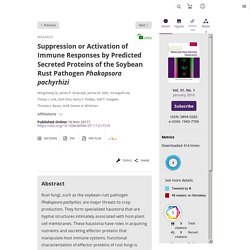
Unraveling the functions of effectors in plants is necessary for understanding the mechanisms that control virulence and pathogenicity and is expected to aid in the development of plant disease resistance (Dangl et al. 2013).